1.はじめに - Introduction
シマジタムラソウ(Salvia isensis ) は,東海地方に分布する小型のサルビアである.
今回,ドイツのマインツ大学 (Johannes Gutenberg-Universitaet Mainz) でサルビアの受粉のメカニズムについて研究しているPetra Westerさんから,タジマタムラソウ,ミヤマタムラソウ,ヒメタムラソウなど,日本のサルビアのおしべのレバーの (=梃子) 動きについて質問を受けた.
これらのおしべは花筒の外に水平に大きく飛び出している.彼女の推測では,多くのサルビア(例えばサルビア・ミクロフィラやサルビア・プラテンシス) に共通して見られる梃子の原理は働かないのではないかということであった.そこで,比較的近い種であり,たまたまこの季節咲いていたシマジタムラソウを調べてみた.
Salvia isensis is a small Salvia, which distributes in Tokai-area of Japan.
Petra Wester of Johannes Gutenberg-Universitaet Mainz (*1) , a researcher of the pollination of Salvias, asked me about the lever mechanism of stamen of some Japanese Salvias, such as Salvia omerocalyx, Salvia lutescens and Salvia pygmaea.
Their stamens are horizontally exserted from corolla tube, and she predicted their lever mechanism may not work, although it is very common feature among many Salvias (e.g. Salvia microphylla or Salvia pratensis). I selected Salvia isensis for observation because it just blooms now and is closely related above mentioned Japanese Salvias.
2.花の外部からの観察 - Observation of flowers from outside
一つの花の開いている日数は,およそ3日程度でとても短い.
開花初日は,おしべ (stamen) がほぼ水平に出ている (fig.1).2日目は,おしべが少し下がり,2本のおしべの間隔が開いたようになる (fig.2).3日目は,おしべが更に下がり,おしべの間隔がふたたび近づいていた (fig.3).さらに翌日は,花筒 (corolla tube) の入り口が閉じ,柱頭 (stigma) の先端がY字に開いたような形になっていた (fig.4).
観察を通じて,おしべの位置は毎日変化があるが,めしべ (pistil) の位置はあまり変わらないように見えた.なお,fig.1〜fig.4は3つの異なる花であるが,おおむねどの花も同じような経過をたどっていた.
A life of a flower was very short, typically 3 days.
On the first day, the stamen positioned mostly horizontal (fig.1). On the second day, the stamen relatively fell down and distance between two stamens became wider (fig.2). On the third day, the stamen fell down more and the distance between two stamens retuned closer (fig.3). Then, the next day, the entrance of corolla tube was completely closed and tip of the stigma opened more like "Y" shaped (fig.4).
During the observation, the position of stamen changed day by day, but the poison of pistil did not so changed. Note: The fig.1 to fig.4 shows three difference flowers, though most flowers represented similar characteristics sof transition.
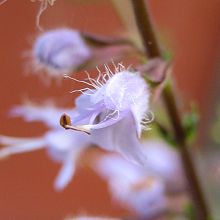
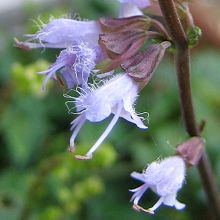
fig.1 (left, 2006-08-04), fig.2 (right, 2006-08-04)
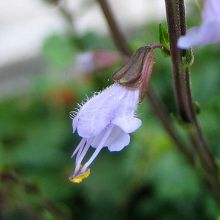
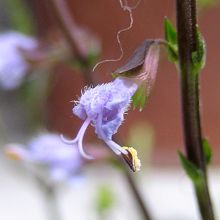
fig.3 (left, 2006-08-02), fig.4 (right, 2006-08-03)
3.おしべの構造について - Structure of stamen
シマジタムラソウのおしべの構造は,いわゆる一般的なサルビア,例えばサルビア・ミクロフィラやサルビア・プラテンシスとは異なるものであった (fig.5 - fig.7).葯隔 (connective) と花糸 (filament) の接合部 (joint area) よりも後部の葯隔はとても短く,しかも花筒の上側近くに位置しているので,花の入り口をブロックするようには出来ていない.
実際に,木の棒(楊枝)を花筒に入れてみたが,Petraの予想した通り,梃子の原理は働かず,おしべは動かなかった.葯隔と花糸は固く結合しており,可動性はほとんど無かった.また,これは多くのサルビアに見られる特徴であるが,後方の葯隔の先には相当に退化した葯 (anther, 半葯 theca という言い方もある) が存在していた.
なお,花の構成要素の寸法は以下の通り.
- 花の長さ (花筒の基部から上唇の先端まで) : 約8mm
- 葯隔の総長 : 約6mm
- めしべの長さ (花柱の基部から柱頭の先端まで) : 約8mm
The structure of the stamen of Salvia isensis is different from other "common" Salvias for example S. pratensis or S. microphylla (fig. 5 to fig.7). The posterior connective, locates after joint area of connective and filament, is very short. It does not seem to block the entrance of corolla tube, because it positiones closely to upper side of corolla tube.
Actually, I inserted small woody rod to the flower, but the lever mechanism did not work as Petra expected and no active movement of stamen was observed. The connective and filament are tightly connected, and there is no movable. An atrophied anther exists on the posterior connective, where this feature is very common among Salvias.
Physical dimensions of flower are as follows;
- Length of flower (from base of corolla to tip of upper lip): approx. 8mm
- Length of total connective: approx. 6mm
- Length of pistil (from base of style to tip of stigma): approx. 8mm
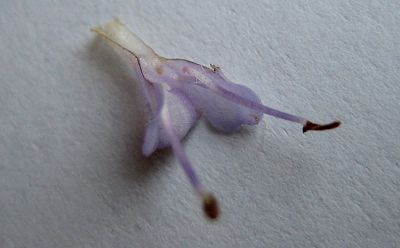
fig.5 (2006-08-07)
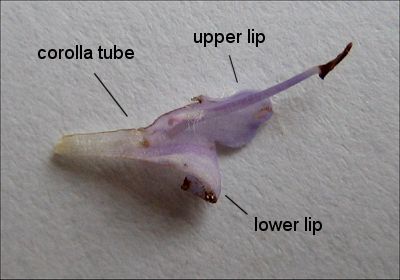
fig.6 (2006-08-07)
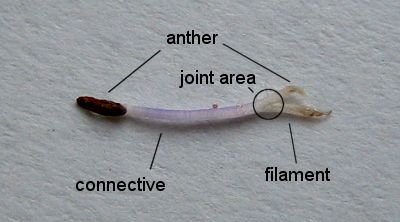
fig.7 (2006-08-07)
4.考察 - Consideration
シマジタムラソウのおしべの構造は,アキギリに代表される日本のサルビアとは異なるものであった.花の形状としては,分布域は相当離れるがサルビア・ユダイカやサルビア・ベルティシラータに近いように思える.
Petra達が研究した論文 (*1) によれば,サルビア・ベルティシラータの場合,花粉は蜂の頭の部分に付くそうなので,シマジタムラソウもそうなのかもしれない.今回観察した期間では訪問者が少なくよく分からなかったので,今後他の日本のサルビアの含め,観察してゆきたい.
The structure of stamen of Salvia isensis is significantly different from Salvia glabrescens, which is one of the representative of Japanese Salvias. It is even more similar shape to Salvia judaica or Salvia verticillata, although their distribution are far from Japan.
As the paper of Petra Wester et al. (*1), pollen deposition will be done at the head of bees for Salvia verticillata, so Salvia isensis might be similar. During my observation this time, there were very a few visitors to the flower; therefore further investigation is necessary not only for Salvia isensis but also other Japanese Salvias.
参考 - References
- (*1) Clasen-Bockhoff, R., Speck, T., Tweraser, E., Wester, P., Thimm, S. & Reith, M. (2004): The staminal lever mechanism in Salvia L. (Lamiaceae): a key syndrome for adaptive radiation? - Organisms, Diversity & Evolution 4(3): 189-205.